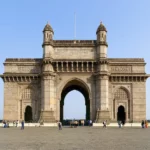Mumbai
Mumbai is a densely populated city on India’s west coast. A financial center, it’s India’s largest city. On the Mumbai Harbour waterfront stands the iconic Gateway of India stone arch, built by the British Raj in 1924. Offshore, nearby Elephanta Island holds ancient cave temples dedicated to the Hindu god Shiva. The city’s also famous as the heart of the Bollywood film industry.
BEST Places to Visit in Mumbai
Gateway of India
The Gateway of India is an arch monument built during the 20th century in Bombay, India. The monument was erected to commemorate the landing of King George V and Queen Mary at Apollo Bunder on their visit to India in 1911.
Built in Indo-Saracenic style, the foundation stone for the Gateway of India was laid on 31 March 1911. The structure is an arch made of basalt, 26 metres (85 feet) high. The final design of George Wittet was sanctioned in 1914 and the construction of the monument was completed in 1924. The Gateway was later used as a symbolic ceremonial entrance to India for Viceroys and the new Governors of Bombay. It served to allow entry and access to India.
The Gateway of India is located on the waterfront at Apollo Bunder area at the end of Chhatrapati Shivaji Marg in South Mumbai and overlooks the Arabian Sea. The monument has also been referred to as the Taj Mahal of Mumbai, and is the city’s top tourist attraction.
Marine Drive
Marine Drive is a 3 kilometre-long Promenade along the Netaji Subhash Chandra Bose Road in Mumbai, India. The road and promenade were constructed by Pallonji Mistry. It is a banana-shaped, six-lane concrete road along the coast of a natural bay. At the northern end of Marine Drive is Girgaon Chowpatty and the adjacent road along links Nariman Point at southern tip to Babulnath and Malabar Hill at northern tip. Marine Drive is situated on reclaimed land facing west-south-west. Marine Drive is also known as the Queen’s Necklace because, when viewed at night from an elevated point anywhere along the drive, the street lights resemble a string of pearls in a necklace.
The official name for this road, though rarely used, is Netaji Subhash Chandra Bose Road. The promenade is lined with palm trees. At the northern end of Marine Drive is Chowpatty Beach. This is a popular beach famed for its Bhel Puri (local fast food). Many restaurants also line this stretch of the road. Further down this road lies Walkeshwar, a wealthy neighborhood of the city, also home to the Governor of Maharashtra.
Siddhivinayak Temple
Shree Ganesh is the first to be worshipped before beginning any new project or venture as he is the destroyer of obstacles (Vighnaharta). This is Shree Siddhivinayak Ganapati Temple at Prabhadevi in Mumbai, a two-century-old Temple that fulfills the desires of the worshipers.
The city of Mumbai is a mute witness to places of worship & historical interest, which are not only popular but also of archaeological importance.
Arguably the most popular & significant places of worship are the Shree Siddhivinayak Ganapati Mandir situated at Prabhadevi. This temple was first consecrated on Thursday 19th November 1801, a fact that is noted in government records. The temple then was a small structure housing the black stone idol of Shree Siddhivinayak, which was two and half feet wide. The outstanding feature of this deity is the tilt of the trunk to the right side. The idol has four hands (Chaturbhuj), which contains a lotus in upper right, a small axe in upper left, holy beads in the lower right and a bowl full of Modaks (a delicacy which is a perennial favorite with Shree Siddhivinayak). Flanking the deity on both sides are Riddhi & Siddhi, goddesses signifying sanctity, fulfillment, prosperity and riches. Etched on the forehead of the deity is an eye, which resembles the third eye of Lord Shiva.
Chhatrapati Shivaji Terminus
Chhatrapati Shivaji Terminus (officially Chhatrapati Shivaji Maharaj Terminus since 2017, formerly Victoria Terminus, Bombay station code: CSMT (mainline) (suburban)), is a historic railway terminus and UNESCO World Heritage Site in Mumbai, Maharashtra, India.
The terminus was designed by a British born architectural engineer Frederick William Stevens from an initial design by Axel Haig, in an exuberant Italian Gothic style. Its construction began in 1878, in a location south of the old Bori Bunder railway station, and was completed in 1887, the year marking 50 years of Queen Victoria’s rule.
In March 1996 the station name was changed from Victoria Terminus to “Chhatrapati Shivaji Terminus” (with station code CST) after Shivaji, the 17th-century warrior king and the first Chhatrapati of the Maratha Empire who founded the state in the western Marathi-speaking regions of the Deccan Plateau.
In 2017, the station was again renamed “Chhatrapati Shivaji Maharaj Terminus” (with code CSMT), where the title Maharaj has literal meaning, “Great king; emperor. Both former initials “VT” and the current, “CST”, are also commonly used.
The terminus is the headquarters of India’s Central Railway. It is one of the busiest railway stations in India, serving as a terminal for both long-distance and suburban trains with a total number of 18 platforms




